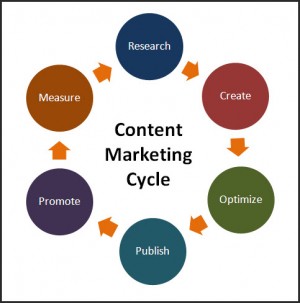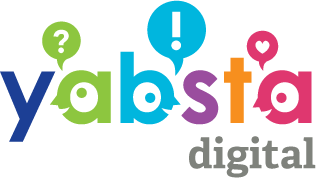If you’re going to be successful at content marketing, you need a plan. While creating and sharing valuable content is a great way to generate leads and build brand awareness, doing it right requires the development of a content marketing plan. A well thought out plan is essential to effective communication with your target audience and gaining a higher return on marketing investment. There is much more to it than simply publishing content and reaping the rewards, and here we recommend a 5-step process to get you on your way.
Set Goals
What do you want to achieve through content marketing? What do you want to gain from the time and money you put into the creation, distribution and promotion of eBooks, blog posts, white papers? Common goals include increasing web traffic, leads and customers, building awareness of your brand, generating blog subscribers and becoming more active online. You should also evaluate current marketing data like conversion and bounce rates.
Research Your Target Audience
Understanding your target audience is key to creating a content strategy that works. Research the demographics and online behaviour of your audience, and consider your ideal customers’ personalities, occupations, needs and wants. Conduct surveys via email, your company website or social media to get a grasp on what potential customers are looking for and how best to connect with them. Another simple, budget-friendly research tactic is to track keyword, product and brand mentions on social networking sites like Facebook and Twitter. What are they doing online and how can you use your content to reach them?
Analyze Your Competition
Take a look at your competitors. Analyze what they’re saying and how they’re disseminating this information and the types of content they’re creating Are they focused on offering downloadable eBooks and white papers, or are they going the business blog route? You can gain an advantage by offering something that you know they’re not. Use a backlink analysis tool such as WooRank or MajesticSEO to see who’s linking to them and why, and search their company name on Twitter and other social media sites to see if, and how, their brand is being discussed. Are they doing something that you should be, but aren’t?
Take Stock
Next, take stock of the content your have already created and distributed and how it performed. Look at social shares, page views, downloads, comments and lead generation and identify which pieces were exceptionally well-received, if any. Next, keeping your target audience in mind, decide on the types of content you want to offer. Popular forms include eBooks, blog posts, infographics, case studies, interviews, surveys, contests, podcasts and webinars.
Schedule Your Plan
Before you go ahead and create content, develop a schedule that alongside your annual business plan. Break it down week by week, day by day if possible. Include the subject matter, content format, the date it is to be published, the distribution channel and the keyword or keyword phrase the piece will be targeting.
Refer back to Step 1 in this process and attach goals to your schedule, such as a certain number of clicks or shares. The more detail, the better. Having your strategy planned out in front of you will help you stick to it.
Setting goals, better understanding your target audience and following competitive activity will allow you to provide content that not only appeals to your target audience but fulfills their industry-specific needs. Once you complete these steps, you’re ready to begin creating and sharing informative, useful information with your audience. Tracking the reach of your content following distribution is a great way to evaluate whether your content marketing plan is getting the job done.
Image Credit: Fernando Biz
If you’re going to be successful at content marketing, you need a plan. While creating and sharing valuable content is a great way to generate leads and build brand awareness, doing it right requires the development of a content marketing plan. A well thought out plan is essential to effective communication with your target audience and gaining a higher return on marketing investment. There is much more to it than simply publishing content and reaping the rewards, and here we recommend a 5-step process to get you on your way.
Set Goals
What do you want to achieve through content marketing? What do you want to gain from the time and money you put into the creation, distribution and promotion of eBooks, blog posts, white papers? Common goals include increasing web traffic, leads and customers, building awareness of your brand, generating blog subscribers and becoming more active online. You should also evaluate current marketing data like conversion and bounce rates.
Research Your Target Audience
Understanding your target audience is key to creating a content strategy that works. Research the demographics and online behaviour of your audience, and consider your ideal customers’ personalities, occupations, needs and wants. Conduct surveys via email, your company website or social media to get a grasp on what potential customers are looking for and how best to connect with them. Another simple, budget-friendly research tactic is to track keyword, product and brand mentions on social networking sites like Facebook and Twitter. What are they doing online and how can you use your content to reach them?
Analyze Your Competition
Take a look at your competitors. Analyze what they’re saying and how they’re disseminating this information and the types of content they’re creating Are they focused on offering downloadable eBooks and white papers, or are they going the business blog route? You can gain an advantage by offering something that you know they’re not. Use a backlink analysis tool such as WooRank or MajesticSEO to see who’s linking to them and why, and search their company name on Twitter and other social media sites to see if, and how, their brand is being discussed. Are they doing something that you should be, but aren’t?
Take Stock
Next, take stock of the content your have already created and distributed and how it performed. Look at social shares, page views, downloads, comments and lead generation and identify which pieces were exceptionally well-received, if any. Next, keeping your target audience in mind, decide on the types of content you want to offer. Popular forms include eBooks, blog posts, infographics, case studies, interviews, surveys, contests, podcasts and webinars.
Schedule Your Plan
Before you go ahead and create content, develop a schedule that alongside your annual business plan. Break it down week by week, day by day if possible. Include the subject matter, content format, the date it is to be published, the distribution channel and the keyword or keyword phrase the piece will be targeting.
Refer back to Step 1 in this process and attach goals to your schedule, such as a certain number of clicks or shares. The more detail, the better. Having your strategy planned out in front of you will help you stick to it.
Setting goals, better understanding your target audience and following competitive activity will allow you to provide content that not only appeals to your target audience but fulfills their industry-specific needs. Once you complete these steps, you’re ready to begin creating and sharing informative, useful information with your audience. Tracking the reach of your content following distribution is a great way to evaluate whether your content marketing plan is getting the job done.
Image Credit: Fernando Biz





